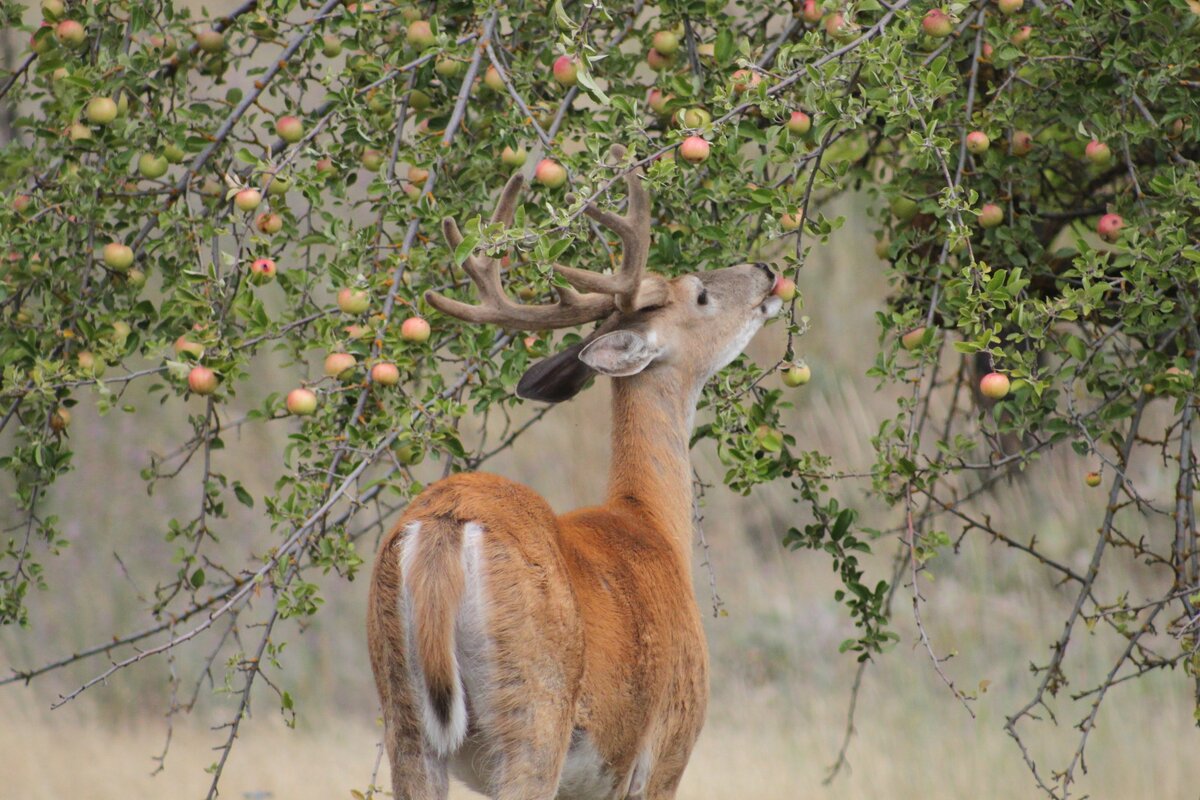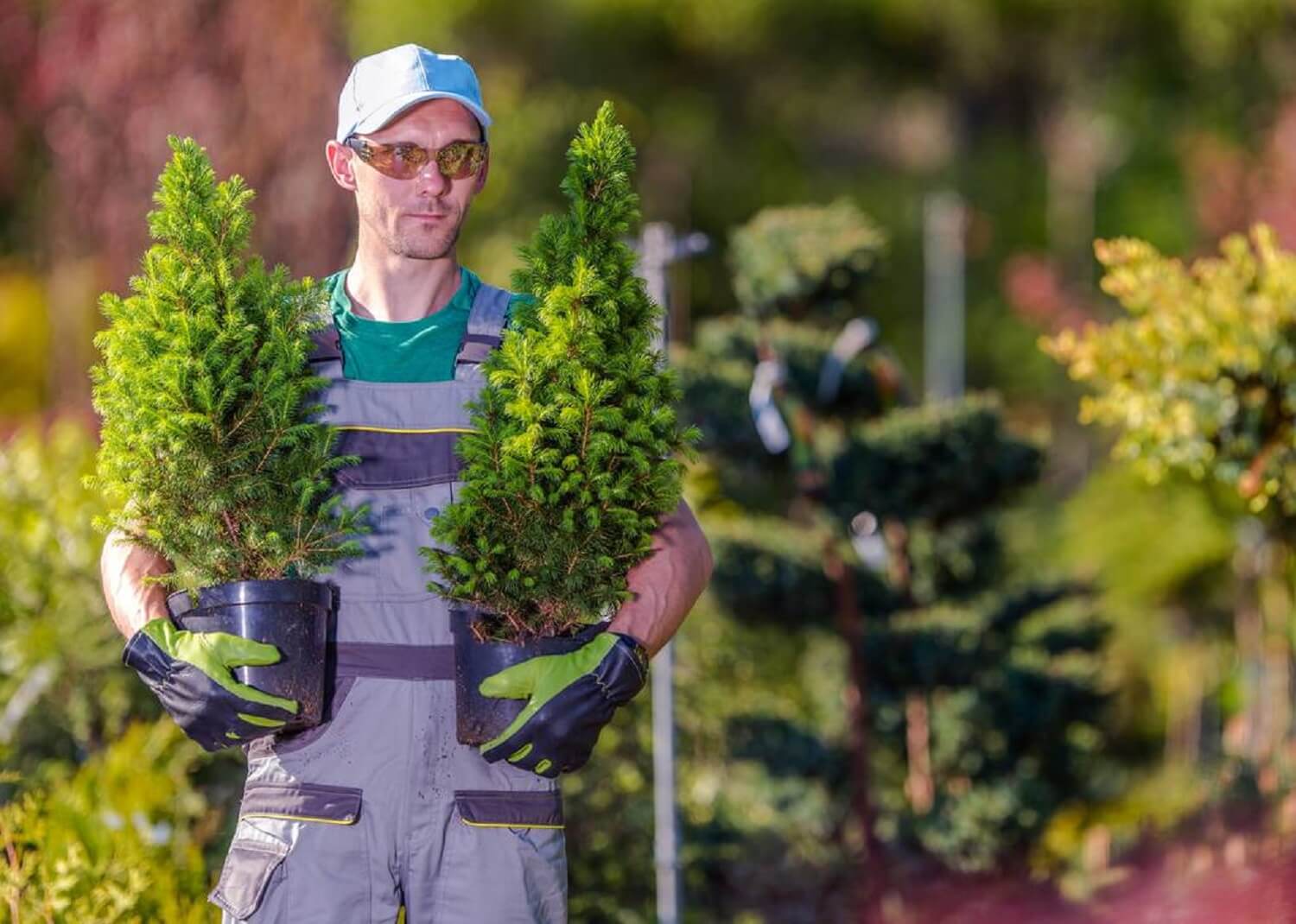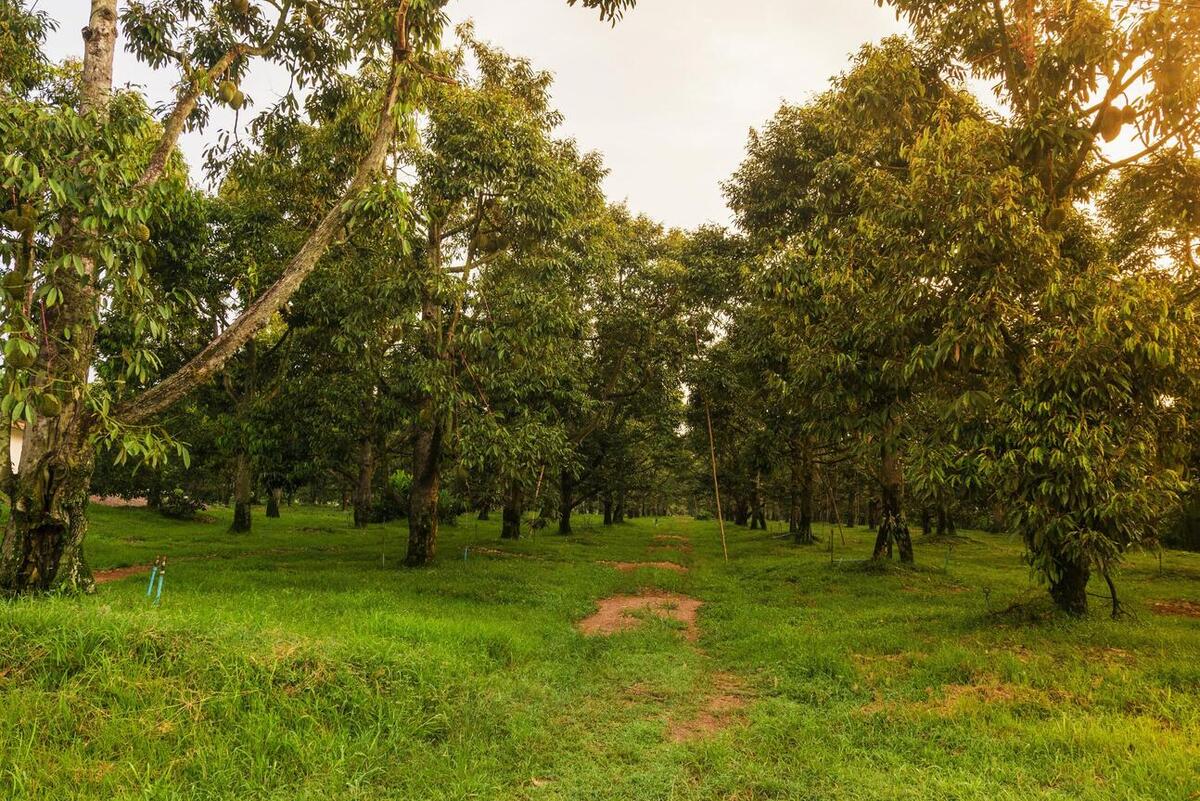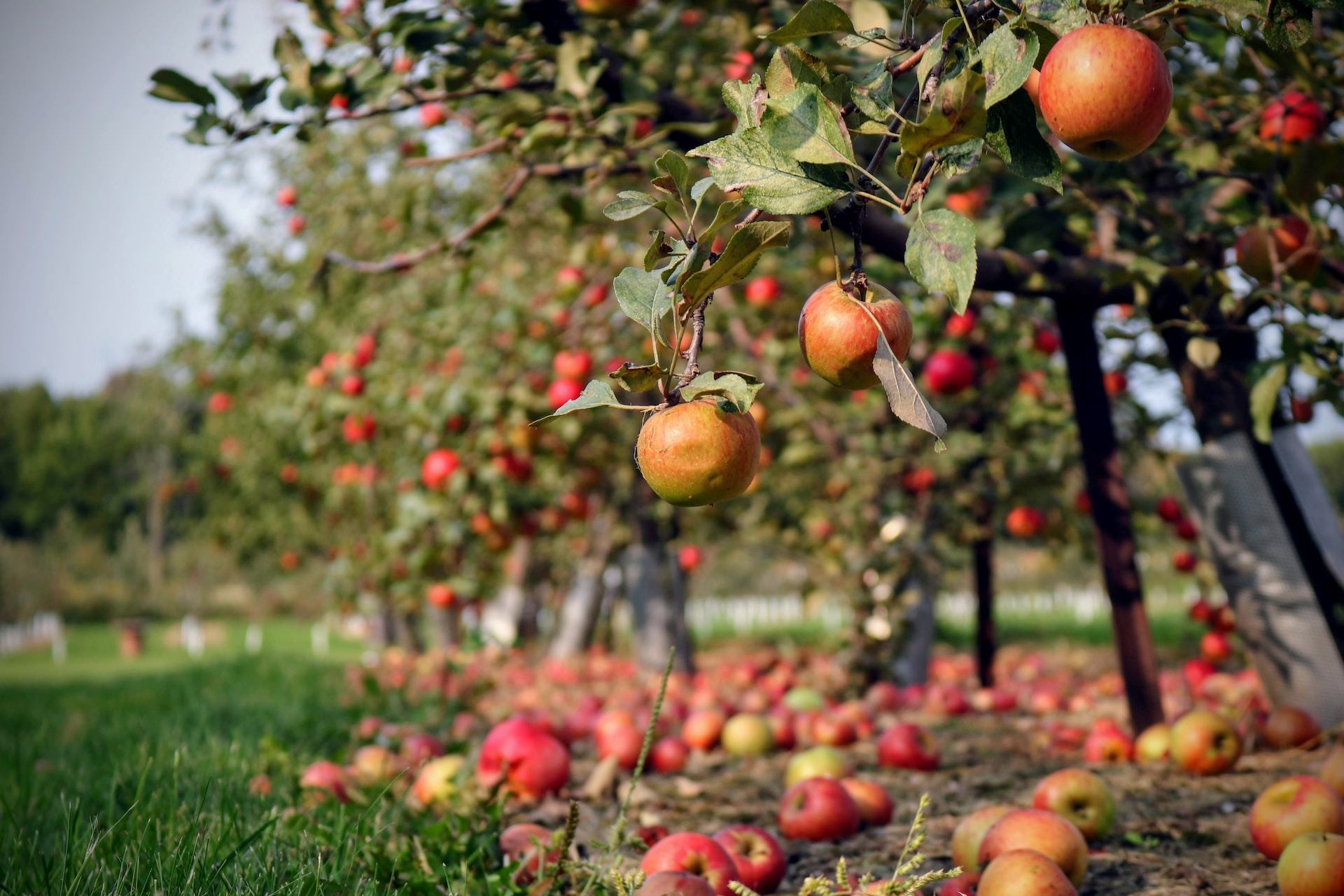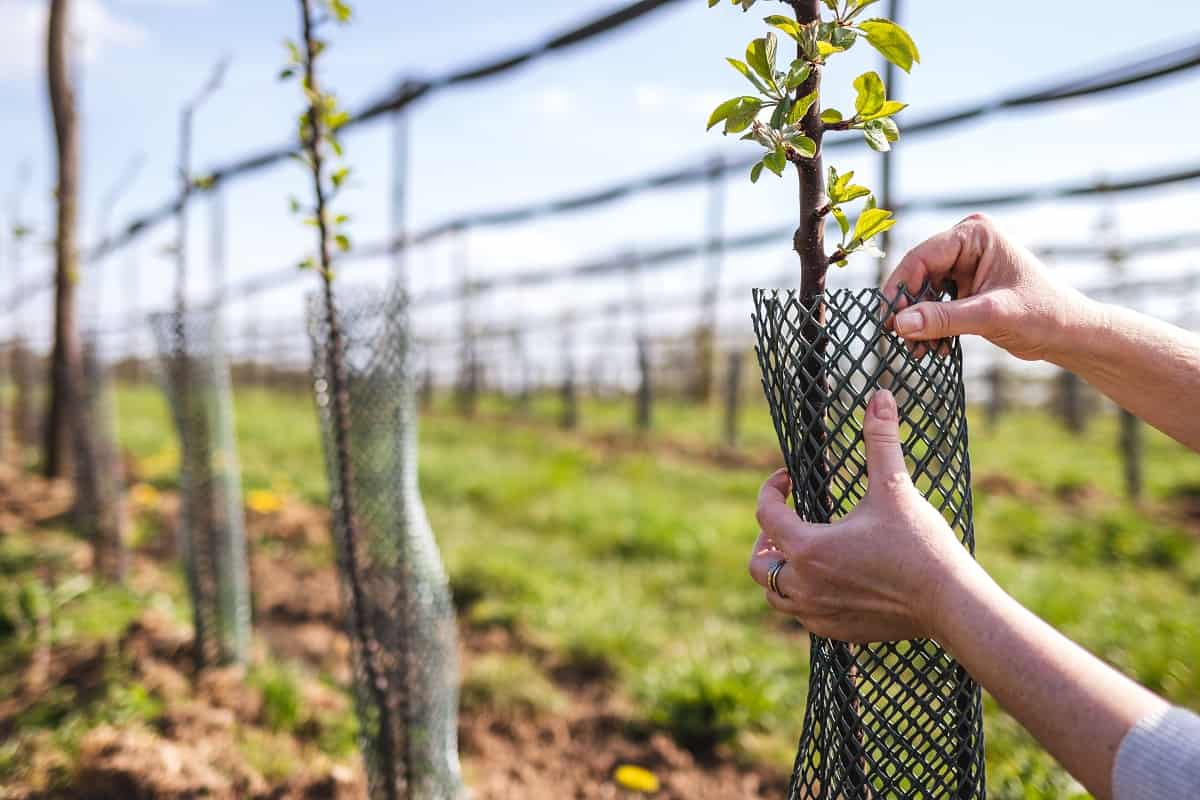Home>Gardening Tips and Tricks>Problem Solving>How To Keep Insects Off Fruit Trees
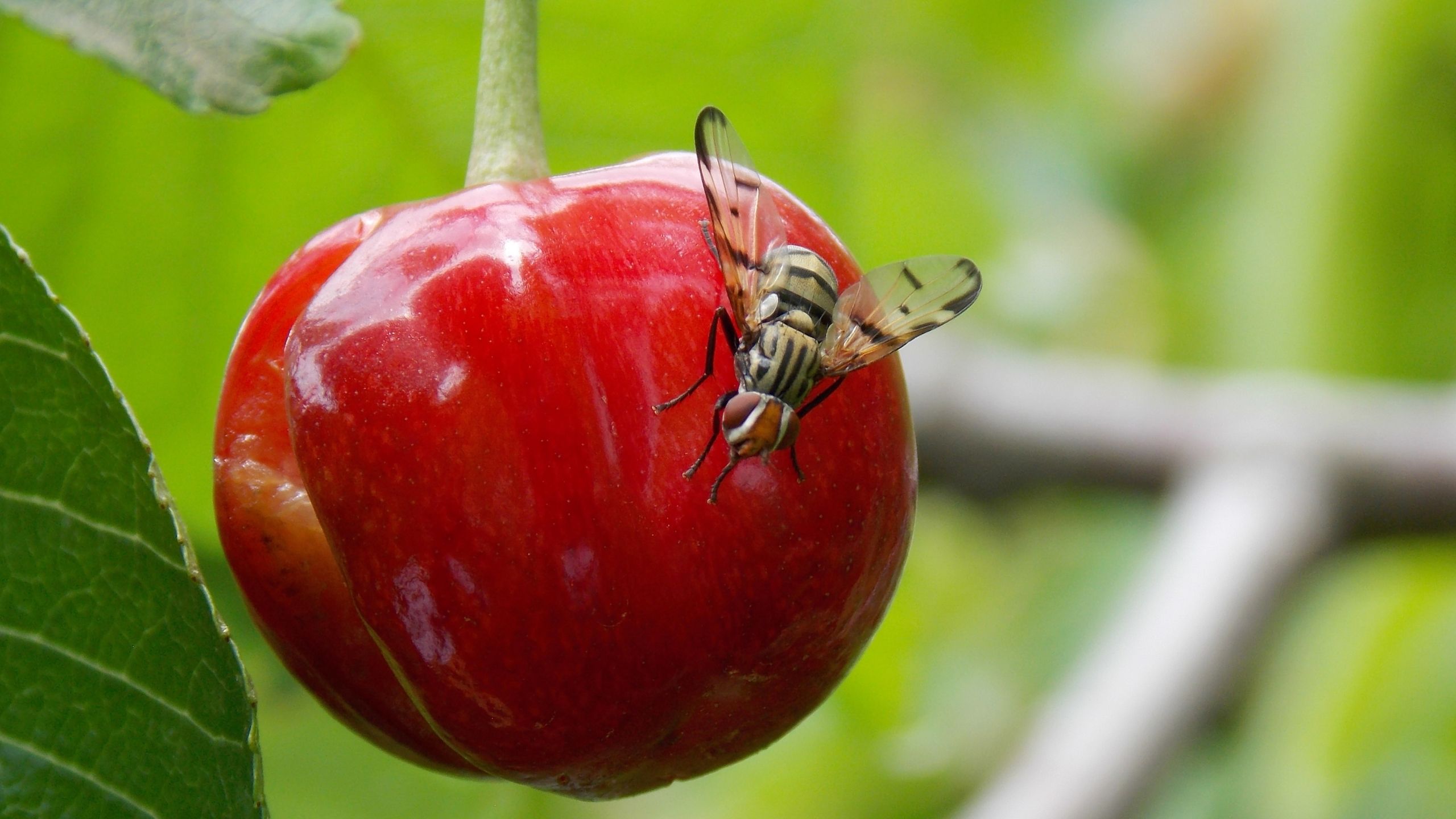

Problem Solving
How To Keep Insects Off Fruit Trees
Modified: January 22, 2024
Learn effective problem-solving techniques to keep insects away from your fruit trees and enjoy a healthy harvest. Discover proven methods to safeguard your trees from pesky pests.
(Many of the links in this article redirect to a specific reviewed product. Your purchase of these products through affiliate links helps to generate commission for Chicagolandgardening.com, at no extra cost. Learn more)
Table of Contents
- Introduction
- Understanding Insect Pests on Fruit Trees
- Natural Methods to Prevent Insects on Fruit Trees
- Proper Tree Maintenance
- Organic Pest Control Products
- Beneficial Insects
- Physical Barriers
- Companion Planting
- Chemical Methods to Eliminate Insects on Fruit Trees
- Insecticidal Sprays
- Systemic Insecticides
- Traps and Baits
- Conclusion
Introduction
Fruit trees are a delightful addition to any yard or garden. The beauty of the blossoms in spring and the bounty of delicious fruits in summer are a joy to behold. However, these precious trees are not immune to the threat of insect pests.
Insects can wreak havoc on fruit trees, causing damage to the leaves, flowers, and fruits. This can lead to reduced yields and poor-quality produce. Fortunately, there are effective methods to keep insects off fruit trees.
In this article, we will explore natural and chemical approaches to prevent and eliminate insect pests on fruit trees. Whether you prefer organic methods or are open to chemical solutions, there are options to suit your preferences and protect your fruit trees.
Understanding the common insect pests that target fruit trees is crucial to implementing appropriate preventive measures. Each insect has its own life cycle, feeding habits, and vulnerabilities. By gaining knowledge about these insects, you can better tailor your pest control approach.
Natural methods rely on environmentally friendly techniques that minimize harm to beneficial insects, birds, and the ecosystem as a whole. These methods include using proper tree maintenance, organic pest control products, beneficial insects, physical barriers, and companion planting.
On the other hand, chemical methods involve the use of insecticidal sprays, systemic insecticides, traps, and baits to eliminate insect pests. While these methods can be effective, it is important to use them responsibly and follow the instructions carefully to avoid harming beneficial insects and pollinators.
In the following sections, we will delve into the natural and chemical methods in more detail, offering insights on their usage and effectiveness in controlling insect pests on fruit trees. By adopting a suitable approach, you can enjoy bountiful harvests and protect the health of your fruit trees for years to come.
Understanding Insect Pests on Fruit Trees
Before we dive into the methods of keeping insects off fruit trees, it’s important to have a basic understanding of the common insect pests that can infest these trees. By identifying the specific pests, you can implement targeted solutions to protect your fruit trees.
One of the most common insect pests is the aphid. Aphids are tiny, soft-bodied insects that feed on the sap of fruit tree leaves, causing them to curl and distort. They reproduce rapidly and can quickly form large colonies, leading to stunted growth and reduced fruit quality.
Another notorious pest is the fruit fly. Fruit flies are attracted to ripening fruits and lay their eggs beneath the skin. The hatched larvae then feed on the fruit, causing rot and spoilage. Fruit flies are especially problematic in warm and humid climates.
Codling moths are also a significant threat to fruit trees. These moths lay their eggs on the fruit, and when the larvae hatch, they tunnel into the fruit, causing internal damage. The presence of frass (insect excrement) and tunnels on the fruit are indications of codling moth infestation.
Scale insects are another common pest found on fruit trees. These small, sap-feeding insects have a protective shell-like covering, making them difficult to detect. Heavy scale infestation can weaken the tree and result in stunted growth and reduced fruit yield.
Other common insect pests include mites, caterpillars, and beetles, each causing their own form of damage to fruit trees. By observing your trees and familiarizing yourself with the signs of infestation, such as leaf damage, fruit degradation, and insect presence, you can take proactive measures to prevent and control these pests.
It is important to remember that not all insects found on fruit trees are harmful. Beneficial insects, such as ladybugs, lacewings, and praying mantises, prey on pest insects and help control their populations naturally. Encouraging a diverse ecosystem in your garden can attract these beneficial insects and help maintain a balanced pest control system.
In the next sections, we will explore natural and chemical methods to prevent and eliminate insect pests on fruit trees. By combining proper tree maintenance, organic pest control products, beneficial insects, physical barriers, and companion planting, you can effectively protect your fruit trees from harmful pests and enjoy a healthy and abundant harvest.
Natural Methods to Prevent Insects on Fruit Trees
When it comes to protecting your fruit trees from insect pests, natural methods can be an effective and environmentally friendly approach. These methods rely on organic techniques that minimize harm to beneficial insects, birds, and the overall ecosystem. Let’s explore some of the natural methods you can implement to keep insects off your fruit trees.
1. Proper Tree Maintenance: Keeping your fruit trees healthy and strong is the first line of defense against insect pests. Prune your trees regularly to remove dead or diseased branches, as they can attract insects. Raking and removing fallen leaves, fruits, and debris can also help eliminate hiding spots for pests.
2. Organic Pest Control Products: There are several natural and organic pest control products available that can help deter and control insect pests on fruit trees. These products use ingredients such as neem oil, insecticidal soap, or pyrethrin derived from chrysanthemums. They are safe for humans, pets, and beneficial insects, while effectively targeting pests like aphids, mites, and caterpillars.
3. Beneficial Insects: Encouraging beneficial insects in your garden can help naturally control pest populations. Ladybugs, lacewings, and parasitic wasps are just a few examples of beneficial insects that feed on harmful pests. You can attract these insects by planting native flowers, providing water sources, and avoiding the use of broad-spectrum pesticides that harm both pests and beneficial insects.
4. Physical Barriers: Protecting your fruit trees with physical barriers can prevent insect pests from reaching your precious fruits. Use fine mesh netting to cover trees or individual branches, preventing access by insects like fruit flies and birds. Additionally, wrapping tree trunks with sticky bands can trap crawling insects and prevent them from climbing up into the tree.
5. Companion Planting: Planting companion plants around your fruit trees can help deter certain insect pests. For instance, marigolds can repel aphids and nematodes, while garlic and chives can discourage codling moths. Research companion planting combinations that work well for your specific fruit tree species and incorporate them into your garden.
Incorporating these natural methods into your fruit tree care routine can provide effective and sustainable pest control. However, it’s important to note that natural methods may require more time and patience to see results compared to chemical methods.
Now that we understand the natural methods to prevent insects on fruit trees, let’s explore the chemical methods that can be used as an alternative for pest control.
Proper Tree Maintenance
Proper tree maintenance is an essential step in preventing insect pests from infesting your fruit trees. By keeping your trees healthy and strong, you create an environment that is less attractive to pests and more resistant to infestation. Here are some key practices to incorporate into your tree maintenance routine:
Regular Pruning: Pruning your fruit trees on a regular basis helps remove dead, damaged, or diseased branches, which can attract insects. It also improves airflow and sunlight penetration, reducing the risk of fungal diseases. Use clean, sterilized pruning tools to make precise cuts, promoting the tree’s overall health.
Sanitation: It is important to remove fallen leaves, fruits, and debris from around the base of the trees. These organic materials can harbor pests or disease-causing pathogens. Proper sanitation minimizes the potential hiding places for insects and reduces the risk of infestation.
Fertilization: Providing your fruit trees with adequate nutrients ensures their vigor and resilience against pests. Use organic fertilizers or compost to enrich the soil with essential nutrients. Avoid excessive use of nitrogen-rich fertilizers, as they can make trees more susceptible to certain pests, such as aphids.
Watering: Consistent and proper watering is crucial for the health of your fruit trees. Water deeply and infrequently, allowing the soil to dry out between watering sessions. This helps prevent the development of fungal diseases and discourages moisture-loving pests.
Protecting against Sunscald: Sunscald can weaken the bark of fruit trees, making them more susceptible to insect infestations. Wrap the trunks of young trees with tree guards or light-colored reflective materials to prevent sun damage. This also acts as a physical barrier against pests like borers.
Monitoring: Regularly inspect your fruit trees for any signs of pest infestation, such as chewed leaves, curled foliage, or distorted fruits. Early detection allows for prompt action, preventing the infestation from spreading and causing significant damage.
By implementing proper tree maintenance practices, you create a strong and healthy environment that is less attractive to insect pests. These preventive measures not only help in pest control but also contribute to overall tree vitality and productivity.
Next, let’s explore the use of organic pest control products as a natural method to prevent and control insect pests on fruit trees.
Organic Pest Control Products
Organic pest control products offer a safe and environmentally friendly way to prevent and control insect pests on fruit trees. These products utilize natural ingredients derived from plants or other organic sources, making them safer for the environment, beneficial insects, and even humans. Here are some commonly used organic pest control products:
Neem Oil: Neem oil is derived from the neem tree and acts as a powerful insect repellent and growth regulator. It disrupts the feeding and reproductive cycles of pests like aphids, mites, and whiteflies. Mix neem oil with water and apply it to the foliage of your fruit trees, ensuring thorough coverage.
Insecticidal Soap: Insecticidal soaps are made from fatty acids and are effective against soft-bodied insect pests such as aphids, mealybugs, and spider mites. These soaps work by suffocating the pests, disrupting their cell membranes. Spray the leaves and stems of your fruit trees with a diluted solution of insecticidal soap.
Pyrethrin: Pyrethrin is a natural insecticide derived from chrysanthemum flowers. It targets a wide range of insects, including aphids, caterpillars, and beetles. Pyrethrin attacks the nervous systems of pests, leading to paralysis and eventual death. Apply pyrethrin-based products according to the instructions on the package.
Garlic Spray: Garlic spray is a homemade pest control remedy that can deter a variety of insect pests. Crush several cloves of garlic and soak them in water overnight. Strain the mixture and transfer it to a spray bottle. Spray the garlic solution on the leaves and branches of your fruit trees to repel insects.
Diatomaceous Earth: Diatomaceous earth is a natural powder made from the fossilized remains of aquatic organisms called diatoms. It acts as a mechanical insecticide, causing pests to dehydrate and die. Sprinkle a thin layer of diatomaceous earth around the base of your fruit trees or directly on the foliage to deter crawling insects.
Organic pest control products are generally safe to use and have minimal impact on beneficial insects, birds, and the environment. However, it is still important to follow the instructions provided by the product manufacturer and exercise caution while applying these products.
Combining proper tree maintenance practices with organic pest control products can provide an effective and sustainable approach to keeping insect pests at bay. In the next section, we will explore the use of beneficial insects as a natural method of pest control on fruit trees.
Beneficial Insects
Beneficial insects play a crucial role in maintaining a balanced ecosystem and controlling insect pests on fruit trees. These insects are natural predators or parasites of harmful pests, helping to regulate their populations without the need for synthetic pesticides. By encouraging beneficial insects in your garden, you can create a natural and sustainable method of pest control for your fruit trees. Here are some common beneficial insects and how they can help:
Ladybugs: Ladybugs, also known as lady beetles, are voracious predators of aphids and other soft-bodied pests. A single ladybug can consume hundreds of aphids in a day. You can attract ladybugs to your garden by planting pollen and nectar-rich flowers such as daisies, yarrow, and fennel.
Lacewings: Lacewings are delicate insects with lacy wings and large, prominent eyes. Both the adult lacewings and their larvae are beneficial predators, feeding on aphids, mites, and small caterpillars. The larvae are particularly voracious and can consume a large number of pests in a short time. To attract lacewings, plant flowers such as dill, coriander, and cosmos.
Parasitic Wasps: Parasitic wasps are tiny, non-stinging wasps that lay eggs inside or on the bodies of pests. The wasp larvae then develop and feed on the pests, eventually killing them. These wasps are effective against pests like caterpillars, scales, and aphids. Planting flowering herbs like parsley, dill, and fennel can help attract parasitic wasps to your garden.
Praying Mantises: Praying mantises are fascinating and beneficial insects that feed on a wide range of pests, including flies, beetles, and caterpillars. They are known for their unique appearance and predatory behavior. Praying mantises can be introduced to your garden by purchasing egg cases from garden centers or specialized suppliers.
Hoverflies: Hoverflies, also known as flower flies, are beneficial insects that play a role in both pollination and pest control. The adult hoverflies feed on nectar, while their larvae are voracious predators of aphids. Planting flowers such as marigolds, calendulas, and alyssums can attract hoverflies to your garden.
Creating a welcoming habitat for beneficial insects includes providing a diverse range of flowering plants, shrubs, and trees in your garden. Avoid the use of broad-spectrum pesticides, as they can harm both harmful and beneficial insects. Additionally, provide water sources like shallow dishes or birdbaths to keep beneficial insects hydrated.
Incorporating beneficial insects into your pest management strategy can significantly reduce the need for chemical interventions and promote a healthy and balanced garden ecosystem. In the next section, we will explore physical barriers as a natural method of preventing insect infestations on fruit trees.
Physical Barriers
Physical barriers are an effective and natural method to prevent insect pests from infesting your fruit trees. By creating physical barriers, you can block access to your trees and protect your precious fruits. Here are some common types of physical barriers used for fruit trees:
Netting: Covering your fruit trees with fine mesh netting is an excellent way to keep insects, birds, and other pests away. The netting acts as a physical barrier, preventing pests like fruit flies and birds from reaching the fruits. Make sure the netting is securely fastened and covers the entire tree or individual branches.
Tree Collars: Tree collars are protective cylinders made of plastic or aluminum that are wrapped around the trunks of fruit trees. These collars can prevent crawling insects, such as borers, from infesting the tree and damaging the bark. Ensure that the collars are properly installed and seal any gaps to ensure effectiveness.
Sticky Bands: Applying sticky bands or barriers around the trunks of fruit trees can help control crawling insects like ants and caterpillars. The sticky surface traps the insects as they crawl up the tree, preventing them from reaching the foliage and fruits. Reapply the sticky material as necessary to maintain its effectiveness.
Traps: Traps are another type of physical barrier used to catch and monitor specific pests. For example, pheromone traps can be used to attract and catch male insects, disrupting their breeding cycle. Traps should be strategically placed around the trees to intercept pests and reduce their population.
When using physical barriers, it’s important to consider factors such as proper installation, regular maintenance, and ensuring the barriers do not cause damage to the tree or hinder airflow and sunlight. Additionally, be mindful of removing fallen fruits and debris from around the base of the tree to minimize potential hiding places for pests.
Physical barriers can be particularly effective when used in combination with other preventive methods like tree maintenance, organic pest control products, and creating a beneficial insect-friendly environment. By implementing physical barriers, you can provide an extra layer of protection for your fruit trees and enjoy a healthier and more abundant harvest.
Now that we’ve explored physical barriers, let’s move on to the concept of companion planting as another natural method to prevent insect infestations on fruit trees.
Companion Planting
Companion planting is a natural and beneficial gardening practice that involves planting specific plants together to promote growth, deter pests, and enhance the health of your fruit trees. By choosing companion plants wisely, you can create a harmonious ecosystem that helps prevent insect infestations on your fruit trees. Here are some key principles and examples of companion planting:
Repellent Plants: Certain plants have natural properties that repel insects, making them excellent companions for fruit trees. For instance, planting marigolds can help deter aphids, nematodes, and other harmful pests. Garlic, chives, and onions are also known to repel pests like codling moths and aphids.
Attract Beneficial Insects: Incorporating plants that attract beneficial insects can help in natural pest control. For instance, planting flowers such as daisies, cosmos, and yarrow can attract ladybugs, lacewings, and hoverflies, which feed on aphids and other pests. The presence of these beneficial insects can help maintain a healthy balance in your garden.
Nitrogen-Fixing Plants: Some plants, like legumes (e.g., beans, peas), have the ability to fix nitrogen in the soil. By planting nitrogen-fixing plants near your fruit trees, you can enhance the soil fertility and promote healthier tree growth. This, in turn, can make your fruit trees more resistant to insect infestations.
Complementary Growth Habits: Choosing companion plants with different growth habits can help optimize space and resources. For example, planting shallow-rooted plants like lettuce or herbs at the base of fruit trees can provide ground cover, suppress weed growth, and reduce competition for nutrients and water.
Interplanting with Deterrent Herbs: Growing aromatic herbs such as rosemary, thyme, and mint near your fruit trees can help deter pests. The strong fragrances of these herbs can confuse insects and mask the scent of the trees, making them less attractive to pests.
When planning your companion planting strategy, consider the specific needs and requirements of your fruit trees, as well as the compatibility of the companion plants. Be mindful of potential competition for resources, spacing considerations, and the growth habits of the plants involved.
Companion planting not only aids in pest management but also enhances biodiversity, increases pollination opportunities, and improves nutrient cycling in the garden. By creating a diverse and well-balanced environment, you can reduce the risk of insect infestations and maximize the health and productivity of your fruit trees.
Now that we’ve explored the benefits of companion planting, let’s move on to the use of chemical methods for eliminating insects on fruit trees.
Chemical Methods to Eliminate Insects on Fruit Trees
While natural methods are preferred for pest control on fruit trees, there may be situations where chemical methods become necessary. Chemical methods can provide more immediate and targeted control of insect pests. However, it’s important to utilize these methods responsibly and with caution to minimize their impact on beneficial insects and the environment. Here are some commonly used chemical methods for eliminating insects on fruit trees:
Insecticidal Sprays: Insecticidal sprays contain synthetic chemicals specifically formulated to kill or repel insect pests. They come in different formulations, such as ready-to-use sprays or concentrate that needs to be diluted with water. It’s crucial to follow the instructions provided by the manufacturer regarding application rates, timing, and safety precautions.
Systemic Insecticides: Systemic insecticides are absorbed by the tree and travel through the vascular system, making them effective against insects that feed on the foliage, such as aphids and caterpillars. They can be applied as soil drenches or injected into the trunk. Systemic insecticides should be used with caution, as they can also affect beneficial insects and bees that visit the flowers.
Traps and Baits: Traps and baits can be used to attract and capture specific pests, reducing their population. For example, pheromone traps can be used to lure and trap male insects, disrupting their breeding cycles. Sticky traps can also be effective in catching flying insects and preventing them from reaching the fruit.
When using chemical methods, it is important to consider the potential risks and benefits. Here are some important considerations:
Targeted Application: Apply chemical treatments only when needed and specifically target the identified pest. Avoid broad-spectrum pesticides that can harm beneficial insects and pollinators.
Timing: Time your applications based on the life cycle of the target pest. This ensures that the treatment is most effective when the pests are vulnerable.
Follow Instructions: Read and follow the instructions provided by the manufacturer carefully. This includes proper handling, protective gear, application rates, and safety precautions.
Residual Effects: Be aware of any residual effects of chemical treatments. Some pesticides can remain on the fruits even after the recommended waiting period. Follow the specified harvest intervals to ensure safe consumption of the produce.
Integrated Pest Management: Consider incorporating a holistic approach to pest management by combining chemical methods with other natural pest control methods. Integrated Pest Management (IPM) aims to minimize the use of chemical pesticides and focuses on prevention, monitoring, and using the least toxic method to control pests.
Remember, chemical methods should be used as a last resort when other preventive and natural methods have not been effective. It’s always important to prioritize the health of your fruit trees and the surrounding ecosystem while effectively managing insect pests.
Now that we’ve explored chemical methods for pest control, let’s conclude with a summary of the methods discussed and their benefits in protecting fruit trees from insects.
Insecticidal Sprays
Insecticidal sprays are a common chemical method used to eliminate insect pests on fruit trees. These sprays contain synthetic chemicals specifically formulated to target and control pests. They can be effective in providing quick and targeted control when natural methods have not been successful or when pest populations are severe. However, it is important to use insecticidal sprays responsibly and with caution to minimize their impact on beneficial insects and the environment.
There are different types of insecticidal sprays available, including ready-to-use sprays and concentrates that need to be diluted with water according to the manufacturer’s instructions. When applying insecticidal sprays, follow these guidelines for best results:
Identify the Target Pest: Determine the specific insect pest you are targeting to select the appropriate insecticide. Different pests may require different active ingredients for effective control.
Read the Label: Carefully read and follow the instructions provided on the pesticide label. This includes information on application rates, timing, protective clothing requirements, and safety precautions.
Timing: Time the application of insecticidal sprays based on the life cycle of the target pest. Some insecticides are most effective when applied during specific stages of the pest’s development, such as when they are in the vulnerable larval stage.
Proper Coverage: Ensure thorough coverage of the tree’s foliage and branches when applying the insecticidal spray. Pay close attention to the areas where the target pests are most likely to be found.
Avoid Blossom Sprays: Do not use insecticidal sprays during the blooming period of fruit trees, as it can harm pollinators like bees. If necessary, select a product that has a short residual effect or use alternative pest control methods during the blooming period.
It’s important to note that the use of insecticidal sprays should be a last resort when other methods have failed or when pest populations pose a significant threat to the health and productivity of the fruit trees. Integrated Pest Management (IPM) approaches that combine multiple methods, including cultural practices, natural predators, and monitoring, should be implemented to minimize reliance on insecticidal sprays.
When using insecticidal sprays, always prioritize the health of your fruit trees, beneficial insects, and the environment. Minimize the impact on non-target organisms by carefully selecting products, following label instructions, and using insecticides sparingly and judiciously. This helps to maintain a balanced ecosystem and ensure the long-term health and productivity of your fruit trees.
Now that we’ve explored the use of insecticidal sprays, let’s move on to the next method: systemic insecticides.
Systemic Insecticides
Systemic insecticides are a type of chemical method used to control insect pests on fruit trees. Unlike topical insecticidal sprays that are applied directly to the surface of the tree, systemic insecticides are absorbed by the tree and transported throughout its tissues, including the leaves, stems, and roots. This allows the insecticide to be ingested by insects that feed on the tree’s foliage or sap, providing a more targeted approach to pest control.
Systemic insecticides are available in different formulations, including soil drenches, injections, and sprays that are absorbed through the leaves. They are effective against a range of pests, including aphids, scales, and caterpillars.
When using systemic insecticides, it is essential to follow these guidelines:
Select the Right Product: Choose a systemic insecticide specifically labeled for use on fruit trees and the target pests you are trying to control. Different insecticides may have varying modes of action and efficacy.
Application Method: Follow the instructions provided by the manufacturer for the correct application method. This may include soil drenching at the tree’s base, trunk injections, or foliar sprays.
Timing: Apply systemic insecticides at the appropriate time in the pest’s life cycle. For example, trees may benefit from treatment before the pests become active or during periods of peak vulnerability, such as during egg hatching.
Care for Beneficial Insects: Be mindful of the potential impact on beneficial insects, such as bees and ladybugs, that may visit the flowers or feed on the pests. Consider using systemic insecticides during periods when these beneficial insects are less active to minimize their exposure.
Pre-Harvest Intervals: Be aware of the pre-harvest intervals specified on the insecticide label. These indicate the number of days that must pass between the last application and the harvest of fruits to ensure compliance with safety standards.
Systemic insecticides provide targeted control against pests that can be challenging to reach with topical sprays. However, it is important to exercise caution when using systemic insecticides to minimize their impact on the environment and beneficial organisms. An integrated approach that combines preventive practices, biological control, and monitoring can help reduce reliance on systemic insecticides.
Remember that the use of systemic insecticides should be based on careful assessment of the pest situation and the potential risks involved. Integrated Pest Management (IPM) strategies that encompass multiple methods, along with proper tree maintenance, can help reduce the need for systemic insecticides while maintaining the health and productivity of fruit trees.
Now that we’ve explored systemic insecticides, let’s move on to the final method: traps and baits.
Traps and Baits
Traps and baits are effective methods to control insect pests on fruit trees. These techniques use specific attractants or lures to lure pests into traps or bait stations, where they are captured or killed. Traps and baits can be used as part of an integrated pest management (IPM) approach to monitor and reduce the population of pests without relying solely on chemical methods.
Pheromone Traps: Pheromone traps utilize synthetic versions of insect sex pheromones to lure and trap male insects. By disrupting the mating cycle, these traps can help reduce pest populations. Pheromone traps are commonly used for pests like codling moths and fruit flies.
Sticky Traps: Sticky traps are coated with a sticky substance that insects get stuck to when they come into contact with it. These traps are effective against flying insects such as aphids, whiteflies, and leafhoppers. They can be hung on the branches of fruit trees or placed near the base to capture pests.
Bait Stations: Bait stations are used to attract and kill specific pests. They contain a mixture of food or pheromones combined with an insecticide. Bait stations can be placed near the affected areas of the tree or on the ground around the tree. They are often used for pests like ants, which can cause damage to fruit trees.
Traps and baits are helpful in monitoring and reducing pest populations. Here are some guidelines to consider when using traps and baits:
Proper Placement: Position traps and bait stations strategically, targeting areas where the pests are most active or likely to be found. This may include branches, foliage, or the base of the tree. Regularly monitor and inspect the traps to assess the level of pest activity.
Timing: Place traps and baits before the pest activity becomes severe or during the peak period of pest infestation. Monitoring early can help detect pest populations and prevent them from causing significant damage to your fruit trees.
Dispose of Captured Insects: Regularly check the traps or bait stations and remove captured insects to ensure the effectiveness of the traps. Proper disposal prevents pests from escaping or infesting other areas of the garden.
Traps and baits are valuable tools for pest monitoring and control, but it is important to keep in mind that they may not eliminate all pests completely. These methods work best when combined with other preventive practices, such as proper tree maintenance, natural predators, and cultural controls.
By integrating traps and baits into an overall pest management strategy, you can effectively reduce pest populations and protect your fruit trees from further damage. Remember to follow the instructions provided by the manufacturer, be mindful of beneficial insects, and assess the effectiveness of these methods regularly.
Now that we’ve explored traps and baits, let’s conclude our discussion on the different methods available to eliminate insects on fruit trees.
Conclusion
Protecting fruit trees from insect pests requires a comprehensive and multi-faceted approach. By utilizing a combination of natural and chemical methods, you can effectively prevent and control insect infestations while considering the health of your fruit trees, beneficial insects, and the environment.
Natural methods such as proper tree maintenance, organic pest control products, beneficial insects, physical barriers, and companion planting offer sustainable and eco-friendly approaches to insect pest management. These methods promote the health and balance of your garden ecosystem and minimize the use of synthetic chemicals.
If natural methods alone are not sufficient to control the pest population, chemical methods such as insecticidal sprays and systemic insecticides can provide targeted control when used responsibly. However, caution must be exercised to minimize the impact on beneficial insects, bees, and the environment.
Traps and baits serve as valuable tools for monitoring and reducing pest populations, complementing the other methods utilized. These methods help capture and eliminate specific pests while minimizing the need for widespread chemical applications.
It is important to note that an integrated approach, such as Integrated Pest Management (IPM), is often the most effective strategy. By combining multiple methods and adapting them to suit your specific circumstances, you can maximize pest control while minimizing negative impacts on the environment.
Remember to closely observe your fruit trees for signs of infestation, regularly monitor pest populations, and employ preventive measures to maintain tree health. Regular tree maintenance, including pruning, sanitation, and proper watering, can go a long way in preventing pest problems. By fostering a diverse garden ecosystem and creating favorable conditions for beneficial insects, you can further enhance the natural pest control process.
Ultimately, the key is to find a balance between pest management and maintaining a healthy and productive fruit tree. With careful attention and the use of appropriate methods, you can enjoy a thriving fruit tree harvest while minimizing the impact of insect pests.

